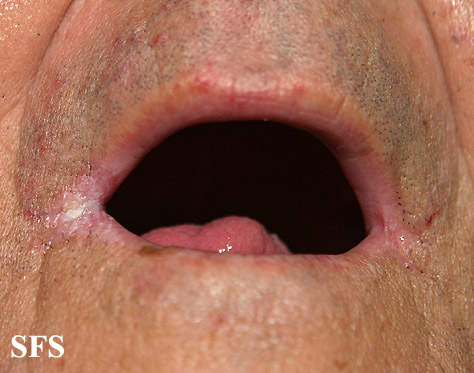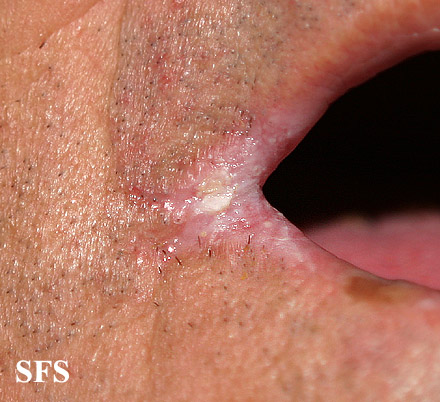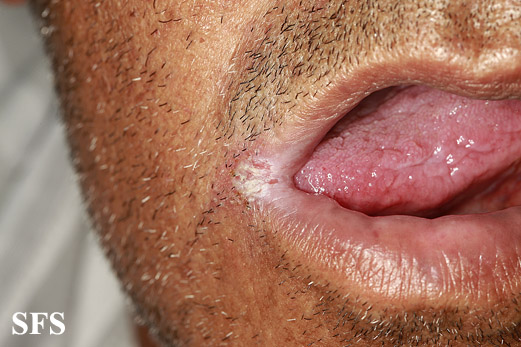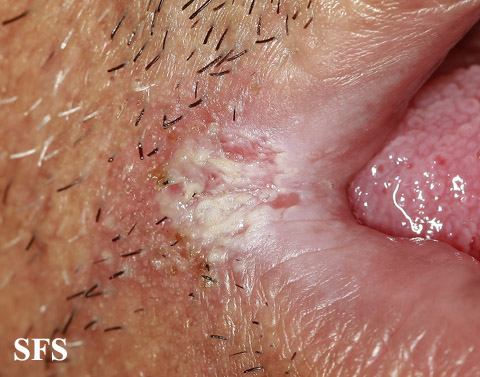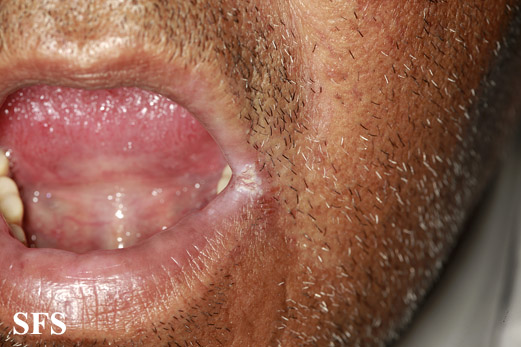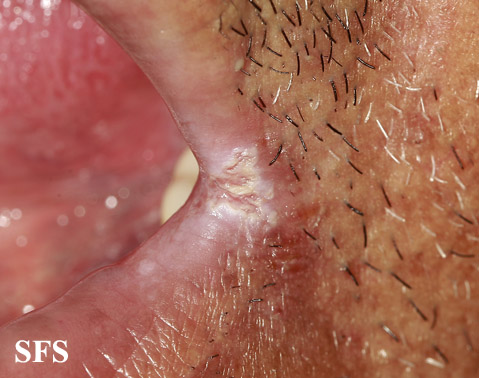Angular cheilitis
| Angular cheilitis | |
| ICD-10 | K13.0 |
|---|---|
| ICD-9 | 528.5 |
|
WikiDoc Resources for Angular cheilitis |
|
Articles |
|---|
|
Most recent articles on Angular cheilitis Most cited articles on Angular cheilitis |
|
Media |
|
Powerpoint slides on Angular cheilitis |
|
Evidence Based Medicine |
|
Cochrane Collaboration on Angular cheilitis |
|
Clinical Trials |
|
Ongoing Trials on Angular cheilitis at Clinical Trials.gov Trial results on Angular cheilitis Clinical Trials on Angular cheilitis at Google
|
|
Guidelines / Policies / Govt |
|
US National Guidelines Clearinghouse on Angular cheilitis NICE Guidance on Angular cheilitis
|
|
Books |
|
News |
|
Commentary |
|
Definitions |
|
Patient Resources / Community |
|
Patient resources on Angular cheilitis Discussion groups on Angular cheilitis Patient Handouts on Angular cheilitis Directions to Hospitals Treating Angular cheilitis Risk calculators and risk factors for Angular cheilitis
|
|
Healthcare Provider Resources |
|
Causes & Risk Factors for Angular cheilitis |
|
Continuing Medical Education (CME) |
|
International |
|
|
|
Business |
|
Experimental / Informatics |
Editor-In-Chief: C. Michael Gibson, M.S., M.D. [1];Associate Editor(s)-in-Chief: Kiran Singh, M.D. [2]
Overview

Angular cheilitis (also called perlèche, cheilosis or angular stomatitis) is an inflammatory lesion at the labial commissure, or corner of the mouth, and often occurs bilaterally. The condition manifests as deep cracks or splits. In severe cases, the splits can bleed when the mouth is opened and shallow ulcers or a crust may form.
Causes
Although the disease has an unknown etiology, the sores of angular cheilitis may become infected by the fungus Candida albicans (thrush), or other pathogens. Studies have linked the initial onset with nutritional deficiencies, namely vitamin B (Riboflavin B2[1] and Cyanocobalamin B12[2]) and iron deficiency anemia[2], which in turn may be evidence of poor diets or malnutrition (e.g. celiac disease).
Cheilosis may also be part of a group of symptoms (upper esophageal web, iron deficiency anemia, glossitis, and cheilosis) defining the condition called Plummer-Vinson syndrome (aka Paterson-Brown-Kelly syndrome).
Angular cheilitis occurs frequently in the elderly population who experience a loss of vertical dimension due to loss of teeth, thus allowing for over-closure of the mouth.
Less severe cases occur when it is quite cold (such as in the winter time), and is widely known as having chapped lips. This lesser form mostly happens to young children/teenagers. The child may lick their lips in an attempt to provide a temporary moment of relief, only serving to worsen the condition.
Diagnosis
Physical Examination
Skin
Mouth
-
Angular Cheilitis. Adapted from Dermatology Atlas.<ref name="Dermatology Atlas">{{Cite
-
Angular Cheilitis. Adapted from Dermatology Atlas.<ref name="Dermatology Atlas">{{Cite
-
Angular Cheilitis. Adapted from Dermatology Atlas.<ref name="Dermatology Atlas">{{Cite
-
Angular Cheilitis. Adapted from Dermatology Atlas.<ref name="Dermatology Atlas">{{Cite
-
Angular Cheilitis. Adapted from Dermatology Atlas.<ref name="Dermatology Atlas">{{Cite
-
Angular Cheilitis. Adapted from Dermatology Atlas.<ref name="Dermatology Atlas">{{Cite
Treatment
In mild cases in teenagers and young children (only having chapped lips), encouraging them not to lick their lips and applying protective paraffin-based ointment (such as Vaseline) or lip balms to the lips is normally very effective.
For more severe angular cheilitis, depending on the cause, antifungal and antibiotic medication (e.g. topical miconazole oral gel that has dual activity), vitamins supplements, and dentures for a person without teeth can abate the symptoms.
References
- ↑ MedlinePlus (August 01, 2005). "Riboflavin (vitamin B2) deficiency (ariboflavinosis)". National Institutes of Health. Check date values in:
|date=(help) - ↑ 2.0 2.1 Lu S, Wu H (2004). "Initial diagnosis of anemia from sore mouth and improved classification of anemias by MCV and RDW in 30 patients". Oral Surg Oral Med Oral Pathol Oral Radiol Endod. 98 (6): 679–85. PMID 15583540.
